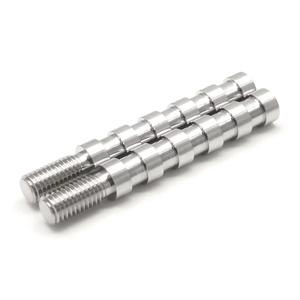Machining the production of steering transmission shafts is a complex and precise manufacturing process. The steering transmission shaft plays a crucial role in the automotive steering system, responsible for transmitting steering force and motion. In terms of material selection, high-strength alloy steel such as 40Cr or 42CrMo is usually chosen to ensure that it has sufficient strength and toughness to withstand complex loads. The preparation of raw materials may be achieved through forging or casting. Forging can improve the internal microstructure of materials and enhance their performance; Casting is suitable for components with complex shapes.
The machining process mainly includes the following key steps:
Turning machining: used to machine the outer circle, shoulder, and end face of the transmission shaft to obtain accurate dimensions and surface roughness.
Milling processing: Process the keyways, splines, and other parts on the transmission shaft to ensure accurate fit with other components.
Drilling and tapping: Used for machining threaded holes for installation and fixation.
During the machining process, it is necessary to strictly control the accuracy indicators such as coaxiality, straightness, and runout of each part. For example, in order to ensure the accuracy and stability of steering, the coaxiality error of the connecting parts at both ends of the transmission shaft must be controlled within a very small range. In order to improve the wear resistance and fatigue strength of the transmission shaft, heat treatment such as quenching and tempering will also be carried out.
The choice between using CNC Turning or CNC Milling to produce Shafts mainly depends on factors such as the design requirements, shape complexity, material characteristics, and production efficiency of the Shafts.
CNC Turning:
CNC Turning is mainly used to produce cylindrical or Shafts with rotational symmetry surfaces. On a CNC lathe, raw materials (such as bars) are rotated while the cutting tool moves axially to remove excess material, resulting in the desired Shafts shape. CNC Turning is particularly suitable for producing long and thin cylindrical Shafts, as the clamping method of the lathe ensures the stability and accuracy of the Shafts during the machining process.
CNC Milling:
CNC Milling is more suitable for producing Shafts with complex shapes and features, such as Shafts with grooves, holes, keyways, etc. On CNC milling machines, raw materials (such as plates or bars) are fixed on the workbench, while rotating cutting tools move along multiple axes to remove excess material and obtain the desired Shafts shape. CNC Milling can achieve more complex machining operations and has higher machining flexibility.
In practical applications, it may sometimes be necessary to combine CNC Turning and CNC Milling to produce Shafts to meet specific design and production requirements.
